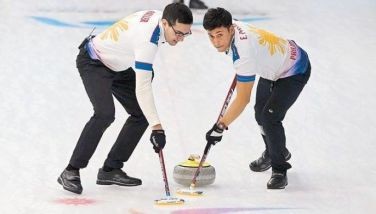Unity

It’s a funny way of fostering national unity: by putting as many of your loyalists in tenured positions and emasculating your successor, and worse, using antedated orders to go around the constitutional ban on midnight appointments.
But critics should be happy enough that President Arroyo, with no more options left to prolong her nine and a half years in power, need not be dragged kicking and screaming away from Malacañang.
The other day, in yet another farewell speech, she called on the nation to unite behind the new leaders, her successor Benigno Aquino III and vice president-elect Jejomar Binay. She need not tell that to her political allies, the majority of whom have now jumped ship for the new ruling group, the Liberal Party (LP).
Yesterday it was Binay’s turn to raise eyebrows by publicly declaring his unwavering support for the incoming president.
Binay denied that he was bitter over losing the interior and local government portfolio. He said he turned down Aquino’s offer for him to head the agrarian reform department, the Metro Manila Development Authority, the housing council or the special commission that would go after GMA (the science and technology department was also reportedly offered) because he would always be an outsider in the LP-dominated Cabinet. P-Noy’s official family had to function as a team, Binay said, and this would be tough in his case because he had campaigned for another president. Binay said he didn’t want to create problems for the only son of the woman to whom he owed his political fortunes.
It’s early days yet, so people are ready to give everyone the benefit of the doubt and hope that the new administration will not start on a bitter, divisive note. Perhaps the incoming president and his constitutional successor, long-time political allies and family friends, can still be reconciled.
* * *
Reconciliation is always tricky, especially when justice is a caveat. The first Aquino administration ended with neither national reconciliation nor justice for many of the thousands of martial law victims.
But when reconciliation works, even to a limited degree, it can do wonders for a wounded nation. Just consider South Africa, now successfully hosting the World Cup after being banned from the games by the FIFA during the apartheid years. It’s the first time that the event is being held in the African continent.
South Africa’s first resident ambassador to Manila, Pieter Vermeulen, is leaving on July 1 after a four-year stay here. The amiable Vermeulen, a career diplomat, is white, one of the Afrikaners who now account for only 10 percent of the South African foreign service, down from more than 90 percent during apartheid. “At one stage,” Vermeulen recalled, “we were lily-white.”
Much of the national healing can be attributed to Nobel peace laureate Nelson Mandela, who reached out to the Afrikaners despite all his apartheid-era suffering, leading his fellow blacks by example in national reconciliation.
Also deserving credit is Archbishop Desmond Tutu, who headed the Truth and Reconciliation Commission that was formed, Vermeulen stressed, not necessarily to punish and give justice but for what its name plainly indicated.
Mandela, now ailing and retired, would not even fire the Afrikaner presidential guards when he assumed power, arguing that the men received special training for the job.
After the end of apartheid, it was inevitable that there were many Afrikaners who felt the reverse tide of racial discrimination. Afrikaners now account for only nine percent of the 48 million population. Some of them are resettling in other countries, with Australia among the preferred destinations.
“What we’re trying to do is take racial enmity out of us… to achieve racial balance,” Vermeulen told me yesterday.
The South African situation is of course markedly different from what we have in the Philippines. But there are always lessons to be learned everywhere.
Two decades after Mandela was sworn in as the country’s first black president, reconciliation is a work in progress.
Among the tools he used effectively for national reconciliation, as you might have already seen in the movie “Invictus,” was sports.
“That’s the beauty of sports in nation building,” Vermeulen said. “It’s a very powerful tool to bring people together.”
Every week the South African embassy in Manila observes “Football Friday,” when officials and employees wear football jerseys to work. Membership in the national football team has gradually changed from predominantly white to black. Just wearing the national team colors, the ambassador said, “sweeps everybody along.”
It’s worth mentioning that hundreds of Filipinos were among the foreigners hired to build or renovate the 10 stadiums now being used for the World Cup in several places in South Africa.
Even after the country won the bid to host the games, there were doubts that South Africa could pull it off. The country adopted the theme, “South Africa: It’s possible.”
By hosting the World Cup, Vermeulen said, “we want to showcase the country as a vibrant place where you get things done… it’s a country that’s functioning well.”
Unemployment is still high at 25 percent. The global economic slump affected South African exports, including all the right-hand-drive BMW 3 series sold around the world, and the country went into recession last year for the first time in three decades. But growth for this year is projected at around six percent, with the World Cup seen as a major contributing factor.
I’ve written in the past that in 1994 when Mandela was sworn in, then President Fidel Ramos sent his vice president who was from a rival political party, Joseph Estrada, as the Philippines’ representative.
Years later, when Mandela’s successor Thabo Mbeki was sworn in, President Arroyo also sent Vice President Noli de Castro to represent the Philippines.
I don’t know if vice president-elect Binay would be willing to serve as P-Noy’s traveling representative. Both of them seem to have an aversion to foreign travel. But the incoming administration cannot afford to start on a sour note between the nation’s two highest officials.
- Latest
- Trending

























